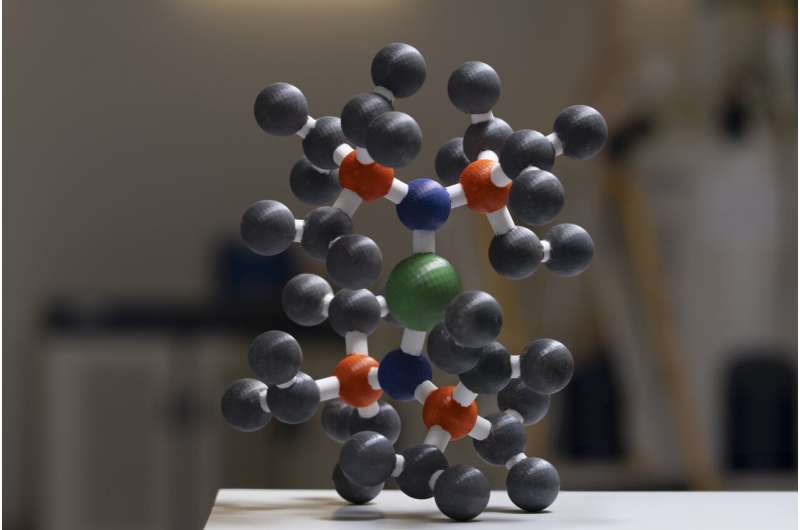In an era where data is considered the new oil, the quest for higher-density, more efficient data storage solutions is relentless. From massive cloud servers to the microchips embedded in our everyday devices, the appetite for data capacity grows exponentially. Now, a groundbreaking development by chemists from The University of Manchester and The Australian National University (ANU) could reshape the landscape of data storage forever: the creation of a new single-molecule magnet (SMM) capable of operating at temperatures as low as the dark side of the moon at night.
These new SMMs herald a future where hard drives the size of postage stamps might hold 100 times more data than today’s best devices. But to appreciate the enormity of this breakthrough, we must understand the scientific, historical, and cultural contexts from which it emerges.
The origin of magnetic data storage
Magnetic storage has been a cornerstone of data preservation since the mid-20th century. Early computers like the UNIVAC used magnetic tapes, and later, IBM’s RAMAC (1956) introduced the first hard disk drive (HDD), forever changing the landscape of digital storage. Over time, engineers refined magnetic domains to pack more information into smaller spaces, culminating in today’s ultra-thin HDDs and solid-state drives (SSDs).
However, these systems have inherent physical limitations. The magnetic domains cannot be reduced infinitely without risking data instability, known as the superparamagnetic limit. Once domains become too small, thermal fluctuations can cause spontaneous flipping, corrupting the stored information. This is where SMMs promise to break the ceiling.
What are single-molecule magnets?
First discovered in the 1990s, SMMs are molecules that exhibit magnetic hysteresis — the property that allows a magnet to retain its magnetic moment — at the molecular level. Unlike traditional magnets composed of billions of atoms working collectively, an SMM operates as a single, coherent magnetic entity.
Historically, the temperatures at which SMMs maintained their magnetization were impractically low (often below 10 Kelvin), making them fascinating for research but irrelevant for practical applications. The recent work from Manchester and ANU represents a quantum leap: these new SMMs remain stable at around 60 Kelvin (about -213°C), roughly the temperature of the moon’s dark side at night. While still cold, this temperature is within reach of liquid nitrogen cooling systems, which are already common in scientific and industrial settings.
Engineering the molecule: Art and science
The design of these new molecules is an intricate dance of chemistry and physics. Researchers meticulously engineer the coordination environment of lanthanide ions (often dysprosium) to optimize magnetic anisotropy and reduce quantum tunneling of magnetization. In simpler terms, they design the molecule’s “landscape” to keep its magnetic moment locked in place, resisting disturbances.
This molecular “landscaping” is akin to crafting a highly detailed sculpture where every curve and edge serves a purpose. Literature often celebrates this meeting of art and science; Leonardo da Vinci’s sketches blend anatomical study with artistic mastery, and Nabokov’s writings on butterflies reflect his scientific rigor and poetic sensibility. Similarly, the chemists’ work on SMMs exists at this intersection — a testament to human creativity and intellect.
Potential impact: Beyond just hard drives
The immediate allure of SMMs lies in data storage. A stamp-sized hard drive using these molecules could theoretically store 100 times more data than a comparable modern HDD. Imagine fitting entire libraries, vast image databases, or decades of video archives into a device small enough to disappear in your pocket.
But the implications stretch far beyond storage. SMMs could revolutionize quantum computing, where individual magnetic moments might serve as qubits — the fundamental units of quantum information. Their ability to maintain stable magnetic states could lead to breakthroughs in quantum error correction and data integrity.
Recent trends: Miniaturization and sustainability
Our collective digital footprint is staggering: humanity generates approximately 2.5 quintillion bytes of data each day. Data centers now account for around 1% of global electricity consumption, a figure that is only expected to rise. As the push for miniaturization and efficiency intensifies, technologies that enable higher data density without corresponding increases in energy consumption become paramount.
SMMs offer a pathway to more sustainable data infrastructures. By allowing significantly more data to be stored in a smaller physical space, they reduce material needs and, potentially, cooling requirements. In a broader environmental context, this aligns with ongoing efforts to mitigate the climate impact of our digital lives.
Historical parallels: Humanity’s drive to preserve
The desire to record, store, and transmit information is as old as civilization itself. From cuneiform tablets in ancient Mesopotamia to medieval illuminated manuscripts and modern silicon chips, each leap in data storage technology reflects our fundamental need to communicate across time and space.
SMMs stand as the latest chapter in this ongoing story. Just as Gutenberg’s printing press democratized access to information in the 15th century, ultra-dense molecular storage could redefine our relationship with digital content, making vast archives more accessible and personal devices exponentially more powerful.
Challenges and next steps
While promising, SMM technology still faces significant hurdles before mainstream adoption. The requirement for low temperatures, though improved, remains a barrier. Researchers are actively exploring ways to push operational temperatures higher, potentially into the realm of everyday devices.
Additionally, integrating molecular magnets into practical device architectures presents formidable engineering challenges. Issues like molecular alignment, read/write mechanisms, and large-scale manufacturing must be resolved before SMM-based storage can move from lab to market.
Culture
Breakthroughs like this often capture public imagination because they tap into science fiction dreams — think of the endless data archives in Star Trek, or the vast virtual libraries in The Matrix. They echo humanity’s perennial quest for knowledge and the tools to safeguard it.
Moreover, the aesthetic beauty of the molecular designs themselves speaks to a cultural yearning for elegance in technology. As our devices become more advanced, there is a growing appreciation for the unseen artistry within microchips, nanostructures, and now, molecular magnets.
Impression
The development of single-molecule magnets by The University of Manchester and ANU researchers represents a pivotal moment in materials science and information technology. It suggests a future where data storage transcends current physical limits, enabling a level of miniaturization and efficiency previously confined to imagination.
In this vision, the hard drive of the future might resemble a postage stamp, yet hold the cumulative memories of lifetimes. SMMs invite us to imagine a world where our digital footprint can shrink even as our capacity for creation and connection expands.
As we look ahead, the challenge will be to translate these elegant molecular marvels into everyday tools, ensuring they enrich human life without compromising our planet. If history is any guide, we can expect that the convergence of art, science, and engineering will continue to push the boundaries of what we believe possible — molecule by molecule, bit by bit.
No comments yet.







